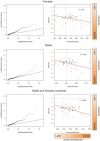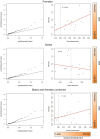Genome-wide association study of sexual maturation in males and females highlights a role for body mass and menarche loci in male puberty
- PMID: 24770850
- PMCID: PMC4168307
- DOI: 10.1093/hmg/ddu150
Genome-wide association study of sexual maturation in males and females highlights a role for body mass and menarche loci in male puberty
Abstract
Little is known about genes regulating male puberty. Further, while many identified pubertal timing variants associate with age at menarche, a late manifestation of puberty, and body mass, little is known about these variants' relationship to pubertal initiation or tempo. To address these questions, we performed genome-wide association meta-analysis in over 11 000 European samples with data on early pubertal traits, male genital and female breast development, measured by the Tanner scale. We report the first genome-wide significant locus for male sexual development upstream of myocardin-like 2 (MKL2) (P = 8.9 × 10(-9)), a menarche locus tagging a developmental pathway linking earlier puberty with reduced pubertal growth (P = 4.6 × 10(-5)) and short adult stature (p = 7.5 × 10(-6)) in both males and females. Furthermore, our results indicate that a proportion of menarche loci are important for pubertal initiation in both sexes. Consistent with epidemiological correlations between increased prepubertal body mass and earlier pubertal timing in girls, body mass index (BMI)-increasing alleles correlated with earlier breast development. In boys, some BMI-increasing alleles associated with earlier, and others with delayed, sexual development; these genetic results mimic the controversy in epidemiological studies, some of which show opposing correlations between prepubertal BMI and male puberty. Our results contribute to our understanding of the pubertal initiation program in both sexes and indicate that although mechanisms regulating pubertal onset in males and females may largely be shared, the relationship between body mass and pubertal timing in boys may be complex and requires further genetic studies.
© The Author 2014. Published by Oxford University Press. All rights reserved. For Permissions, please email: journals.permissions@oup.com.
Figures


References
-
- Palmert M.R., Boepple P.A. Variation in the timing of puberty: clinical spectrum and genetic investigation. J. Clin. Endocrinol. Metab. 2001;86:2364–2368. - PubMed
-
- Morris D.H., Jones M.E., Schoemaker M.J., Ashworth A., Swerdlow A.J. Familial concordance for age at menarche: analyses from the Breakthrough Generations Study. Paediatr. Perinat. Epidemiol. 2011;25:306–311. - PubMed
-
- Silventoinen K., Haukka J., Dunkel L., Tynelius P., Rasmussen F. Genetics of pubertal timing and its associations with relative weight in childhood and adult height: the Swedish Young Male Twins Study. Pediatrics. 2008;121:e885–e891. - PubMed
Publication types
MeSH terms
Substances
Grants and funding
- RC2 MH089951/MH/NIMH NIH HHS/United States
- MOP-82893/CAPMC/ CIHR/Canada
- 068545/Z/02/WT_/Wellcome Trust/United Kingdom
- 092731/WT_/Wellcome Trust/United Kingdom
- DH_/Department of Health/United Kingdom
- 076113/WT_/Wellcome Trust/United Kingdom
- 102215/WT_/Wellcome Trust/United Kingdom
- MC_UP_A620_1014/MRC_/Medical Research Council/United Kingdom
- U01 DK062418/DK/NIDDK NIH HHS/United States
- MC_U106179472/MRC_/Medical Research Council/United Kingdom
- MC_UU_12013/1/MRC_/Medical Research Council/United Kingdom
- 090532/WT_/Wellcome Trust/United Kingdom
- 098395/WT_/Wellcome Trust/United Kingdom
- G0000934/MRC_/Medical Research Council/United Kingdom
- 098051/WT_/Wellcome Trust/United Kingdom
- G9815508/MRC_/Medical Research Council/United Kingdom
- RC2 MH089995/MH/NIMH NIH HHS/United States
- MC_UU_12013/3/MRC_/Medical Research Council/United Kingdom
- MC_UU_12015/2/MRC_/Medical Research Council/United Kingdom
- MC_PC_15018/MRC_/Medical Research Council/United Kingdom
- MC_UU_12011/1/MRC_/Medical Research Council/United Kingdom
- NIMH 1RC2MH089995-01/RC/CCR NIH HHS/United States
LinkOut - more resources
Full Text Sources
Other Literature Sources
Medical

